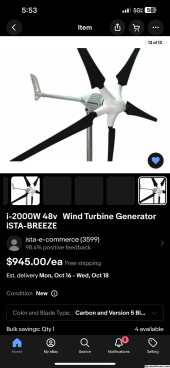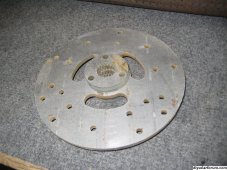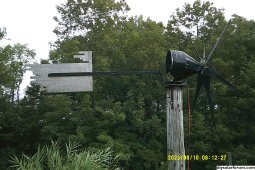You are using an out of date browser. It may not display this or other websites correctly.
You should upgrade or use an alternative browser.
You should upgrade or use an alternative browser.
Which Turbine?
- Thread starter cockatoo
- Start date
OzSolar
Whatever you did, that's what you planned.
So you built a turbine! How fun! About the only "modern" (~1980 or newer) wind turbines that I heard or saw much positive about were the homebuilt ones, in particular the designs that High Pigott writes books about and puts workshop on. The ARE wind turbines were very interesting but they were only around for a few years (around 2005??) but are long gone now.Yes, I built it two years ago from an F&P motor per instructions from TheBackShed site, 4x3C Star pattern for general 12v or 24v use. As for "usable energy", it feeds a set of 12v AGM 100ah batteries (parallel for now) when the wind blows (like yesterday) and has filled the battery to full given the sounds of the relay clicking the dump load on and off. I also have a PowMr MPPT solar controller (and two dedicated 100w panels) hooked up to the same set of batteries for days when there is little wind available. This system runs a 40w heated water basin in the winter along with the pond bubbler (40w also).
What are you using for blades?
If there is solar on your same battery bank and you aren't datalogging them separately it's impossible to tell how much energy either one is contributing to your system. Without knowing which one is putting Watthours (not watts) into the batteries and loads "usable energy" it's supposition.
As far as my definition of usable energy, it's not so much about cherry picking the the windiest days of the month that are totally unpredictable at most sites, its more about being able to rely on the energy source (kWh) most days of the year for many years in a row.
Hogheavenfarm
Regulation Stifles Innovation
- Joined
- Jun 24, 2022
- Messages
- 432
It was a very interesting project, and useful as well, but to provide what I needed I went to solar afterwards, but I kept this project for the barn to supply small loads over the winter, when we have the best wind and when I need the heaters running. At the moment I have the 7 blade Raptor series (carbon fiber) on it, but I used the waterjet to cut several other hubs so I can run 5 or 3 blades if the situation requires it. Blades were from MWAS, so was the 440 amp controller. Maytag donated the washer after several repairs and we got a new "conventional" one. All my knowledge came from Hugh and several others who had built them successfully. Most of them were bigger (10ft diam) so I scaled down my build by 1/2, so far it seems to work ok, but have not tested the furling ability yet, something I will probably see soon.
Attachments
I'll keep an eye on this thread, because I'm also searching for a turbine. I live in a very windy area, where it definitely will work.
However, all I've seen is either way too expensive, or seems to be very low quality. Most are too small. When you read the fine print you'll realize how little power they give in modest winds.
I also worry about infrasound that might be a health hazard, and potential dangers during storms. I'm way in the middle of nowhere, so at least I will not bother anyone with my project.
For now I'll rely on an over sized solar array in combination with a petrol generator in the winter.
However, all I've seen is either way too expensive, or seems to be very low quality. Most are too small. When you read the fine print you'll realize how little power they give in modest winds.
I also worry about infrasound that might be a health hazard, and potential dangers during storms. I'm way in the middle of nowhere, so at least I will not bother anyone with my project.
For now I'll rely on an over sized solar array in combination with a petrol generator in the winter.
wopachop
New Member
Never heard of infrasound until now. You read that wind turbines can produce this low frequency?I also worry about infrasound that might be a health hazard
Warpspeed
Solar Wizard
Only the really ginormous commercial turbines hundreds of feet high with huge blades that turn very slowly can produce these high amplitude sub audio frequencies.Never heard of infrasound until now. You read that wind turbines can produce this low frequency?
Anything you could build at home will be much smaller and turn much faster, and any noise produced will be of a higher frequency and of much lower intensity.
OzSolar
Whatever you did, that's what you planned.
See if you can find a Windrose chart for a location close to you. It will help you determine how many hours per year the wind blows at a certain speed. I just found one for a site in Sweden here. It might take a few minutes to learn how to read them but they are quite powerful tools.However, all I've seen is either way too expensive, or seems to be very low quality. Most are too small. When you read the fine print you'll realize how little power they give in modest winds.
I still have to really study them closely but at first glance I can gather that the wind typically comes from the SW and that green, yellow and orange account for least 50%, if not much more, of the graph's area. That means the wind speed was less than 6.5 m/s well over half of the of the time during the period this data was collected. Perhaps even as much as 75% of the time. 8.5 m/s or above doesn't just happen that often. 10m/s is the minimum I've seen most turbines rated at.
Ideally they would have already tabulated the data for you but still this is a good example.
The practical takeaway is that at this site a small wind turbine on a 10M or less tower will spend most of time making almost no energy.
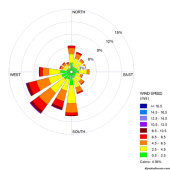
That would be wise, you can probably buy at least 10 years worth of petrol for what you'd spend on a even a cheap wind turbine by the time you got the tower and wire in between. What is your current annual spend on petrol for the generator? (in USD if you don't mind making the conversion for me)For now I'll rely on an over sized solar array in combination with a petrol generator in the winter.
Warpspeed
Solar Wizard
If you have an airport nearby, they will have all the information available.See if you can find a Windrose chart for a location close to you.
Last edited:
You're probably right, perhaps doesn't apply to smaller turbines. Infrasound is a big problem with the big installations here in Sweden. Many residents in nearby areas complain of headaches, etc.Only the really ginormous commercial turbines hundreds of feet high with huge blades that turn very slowly can produce these high amplitude sub audio frequencies.
Anything you could build at home will be much smaller and turn much faster, and any noise produced will be of a higher frequency and of much lower intensity.
Great find, thanks. I'll contact them for the data.See if you can find a Windrose chart for a location close to you. It will help you determine how many hours per year the wind blows at a certain speed. I just found one for a site in Sweden here. It might take a few minutes to learn how to read them but they are quite powerful tools.
I still have to really study them closely but at first glance I can gather that the wind typically comes from the SW and that green, yellow and orange account for least 50%, if not much more, of the graph's area. That means the wind speed was less than 6.5 m/s well over half of the of the time during the period this data was collected. Perhaps even as much as 75% of the time. 8.5 m/s or above doesn't just happen that often. 10m/s is the minimum I've seen most turbines rated at.
Ideally they would have already tabulated the data for you but still this is a good example.
The practical takeaway is that at this site a small wind turbine on a 10M or less tower will spend most of time making almost no energy.
View attachment 173835
That would be wise, you can probably buy at least 10 years worth of petrol for what you'd spend on a even a cheap wind turbine by the time you got the tower and wire in between. What is your current annual spend on petrol for the generator? (in USD if you don't mind making the conversion for me)
Global wind atlas shows my location having average wind speeds of 8 m/s. But since it doesn't know the specifics about my property, I'd say it underestimates, because it is mostly free from trees, and at a peak elevation compared to the surroundings.
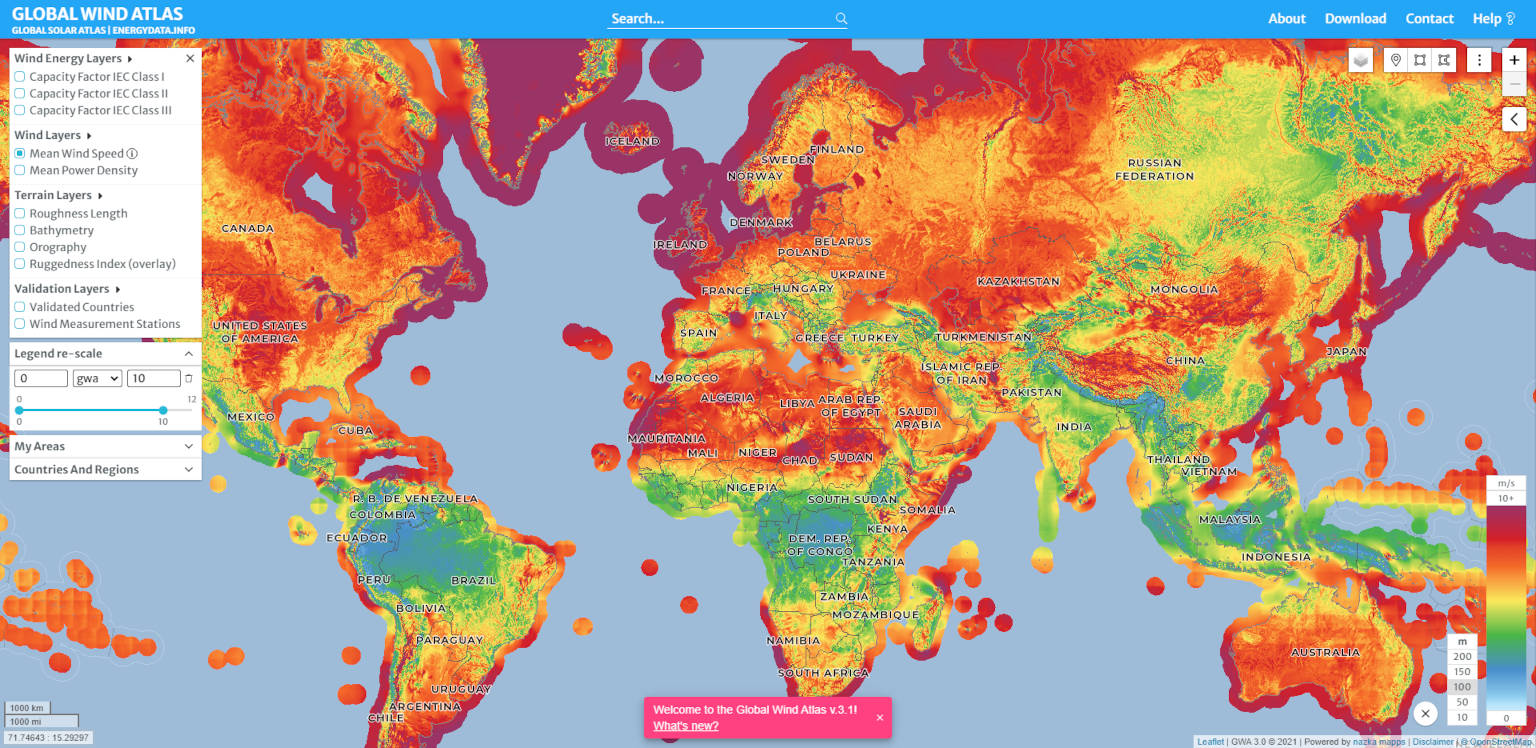
Global Wind Atlas
The Global Wind Atlas is a free, web-based application developed to help policymakers, planners, and investors identify high-wind areas for wind power generation virtually anywhere in the world, and then perform preliminary calculations.
I consume around 100 L (22 gallons) of petrol per year for the inverter, relatively little. With Swedish prices that comes to around $200. So money isn't an issue, but the fact that I have to rely on it. It's another part that might break in middle of winter and leave me exposed. I'd rather have it be a backup if something fails, than to be an integral part of my winter experience.
OzSolar
Whatever you did, that's what you planned.
Please let us know how that experience works out! It would be amazing to learn you had a site with a 8 m/s average at a hub height you can get to. The Global Wind Atlas defaults to a 100m hub height so you might be sure you are selecting 10m and see if what it tells you changes.Great find, thanks. I'll contact them for the data.
I get it, I really do. Sounds like you've got realistic expectations. Look into the home made "brake disc" turbine plans by Hugh Piggott.'I'd rather have it be a backup if something fails, than to be an integral part of my winter experience.
The subject of how to boost the miserable winter production of solar comes up often.
brandnewb
Going for serious. starting as newb
no no no no. wind is not yet to be discarded.This is what people do since it is the simplest and most reliable long term. Install enough solar to cover you over winter and yes you will have more excess in Summer but so what?Much easier and less complicated than dealing with flaky wind turbines that will last only a fraction of the time a solar install will.
hmm even while typing I realize how wrong I could be.
But I imagine all you guys living on large acres of land and then I stand by with I have said.
But when in close quarters urban settings then I must, even though it breaks my heart, agree to the premise.
peakbagger
Solar Enthusiast
- Joined
- Oct 26, 2021
- Messages
- 309
I briefly worked for a long term maker of wind turbines in VT, they started out in the sixties salvaging old Jacobs type 1930s style turbines and eventually started building them including the first turbine near the South Pole. They kept at it and with government funds built winterized turbines for wind/diesel installations that were popular in Alaska to reduce diesel costs. Many of the core group had been around turbines for decades but very few had operating units for their own as they didnt have the time to maintain them. The way to keep a wind turbine running is to maintain it once a year and that means either climbing the pole or dropping the pole and working on it on the ground. Almost all of them switched to solar as it was a lot less work.
BTW on their larger units they had an option to slowly turn the blades, it was represented as means of rotating the blades in place to be inspected but it was a popular option for turbines in visible areas to give the illusion that the turbine was actually running.
BTW on their larger units they had an option to slowly turn the blades, it was represented as means of rotating the blades in place to be inspected but it was a popular option for turbines in visible areas to give the illusion that the turbine was actually running.
brandnewb
Going for serious. starting as newb
I love your input, and please never stop. because that is what our community is built on. But I am not sure we all can fully appreciate what it is you meant.I briefly worked for a long term maker of wind turbines in VT, they started out in the sixties salvaging old Jacobs type 1930s style turbines and eventually started building them including the first turbine near the South Pole. They kept at it and with government funds built winterized turbines for wind/diesel installations that were popular in Alaska to reduce diesel costs. Many of the core group had been around turbines for decades but very few had operating units for their own as they didnt have the time to maintain them. The way to keep a wind turbine running is to maintain it once a year and that means either climbing the pole or dropping the pole and working on it on the ground. Almost all of them switched to solar as it was a lot less work.
BTW on their larger units they had an option to slowly turn the blades, it was represented as means of rotating the blades in place to be inspected but it was a popular option for turbines in visible areas to give the illusion that the turbine was actually running.
Perhaps it is a formatting issue or a something lost in translation? Please remember that most of us are from abroad.
Last edited:
peakbagger
Solar Enthusiast
- Joined
- Oct 26, 2021
- Messages
- 309
Not sure about how many folks are from abroad but the short form is unless you like wasting your money dont buy or install small wind unless you are in the very small minority of locations where it might make sense.I love your input, and please never stop. because that is what our community is built on. But I am not sure we all can fully appreciate what it is you meant.
Perhaps it is a formatting issue or a something lost in translation? Please remember that most of us are from abroad.
brandnewb
Going for serious. starting as newb
agreed
OzSolar
Whatever you did, that's what you planned.
Northern Power Systems I assume.BTW on their larger units they had an option to slowly turn the blades, it was represented as means of rotating the blades in place to be inspected but it was a popular option for turbines in visible areas to give the illusion that the turbine was actually running.
Yep, back when I was installing 60kW to 150kW wind turbines, mostly for demonstration projects, there was usually some sort of ribbon cutting/kick off event. I can confirm that it was pretty standard practice to put the turbine into motor mode so it would spin during the event.
peakbagger
Solar Enthusiast
- Joined
- Oct 26, 2021
- Messages
- 309
I worked for the Northern Power when it was a division of Distributed Energy and Wall Street drove it in the ground. They were pushing the Artic grade Northwind 100s real hard onto the market and they were being installed all over the place mostly for PR projects.
OzSolar
Whatever you did, that's what you planned.
Very familiar with all of that. One of my retirements was cleaning up the messes the buffoons made.I worked for the Northern Power when it was a division of Distributed Energy and Wall Street drove it in the ground. They were pushing the Artic grade Northwind 100s real hard onto the market and they were being installed all over the place mostly for PR projects.
Hedges
I See Electromagnetic Fields!
- Joined
- Mar 28, 2020
- Messages
- 20,695
I consume around 100 L (22 gallons) of petrol per year for the inverter, relatively little. With Swedish prices that comes to around $200. So money isn't an issue, but the fact that I have to rely on it. It's another part that might break in middle of winter and leave me exposed. I'd rather have it be a backup if something fails, than to be an integral part of my winter experience.
Diesel you might be able to also make at home.
Perhaps your gas doesn't go bad as fast as ours.
Propane is forever. You might need 5x 5 gallon "BBQ" tanks instead of the petrol.
(but propane in cold climate could need heating.)
Similar threads
- Replies
- 1
- Views
- 305
- Replies
- 31
- Views
- 1K
- Replies
- 0
- Views
- 254
- Replies
- 9
- Views
- 652



